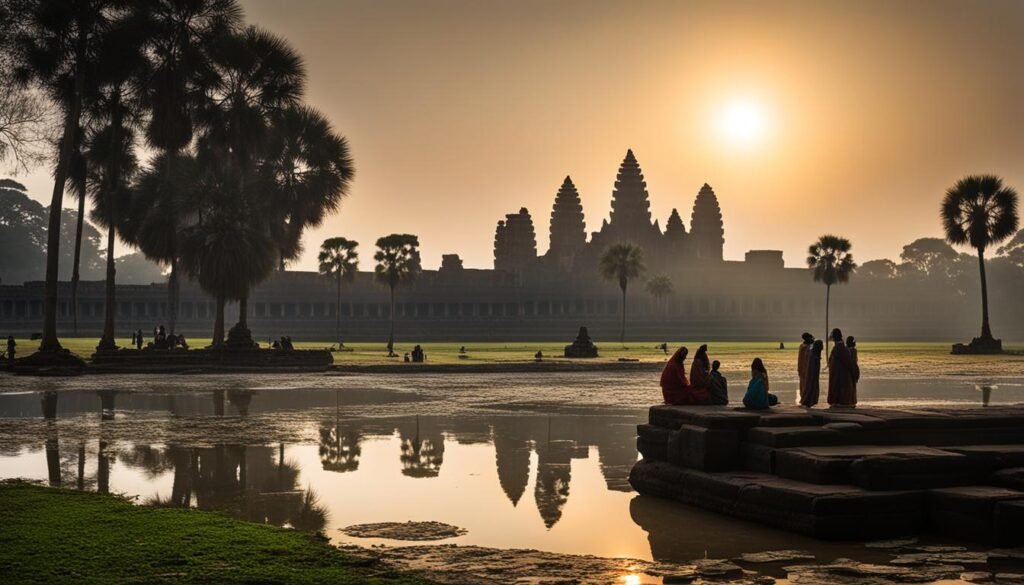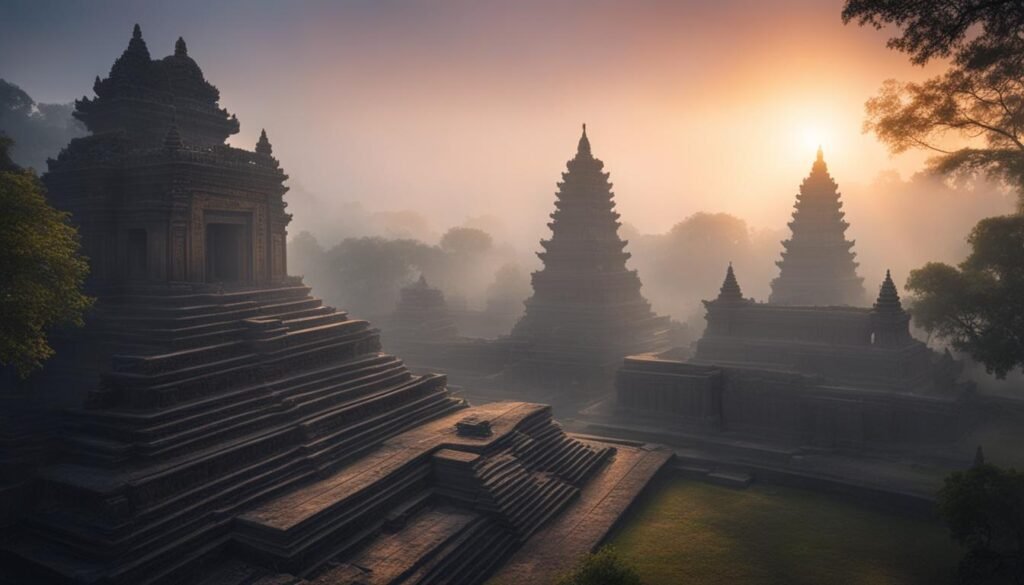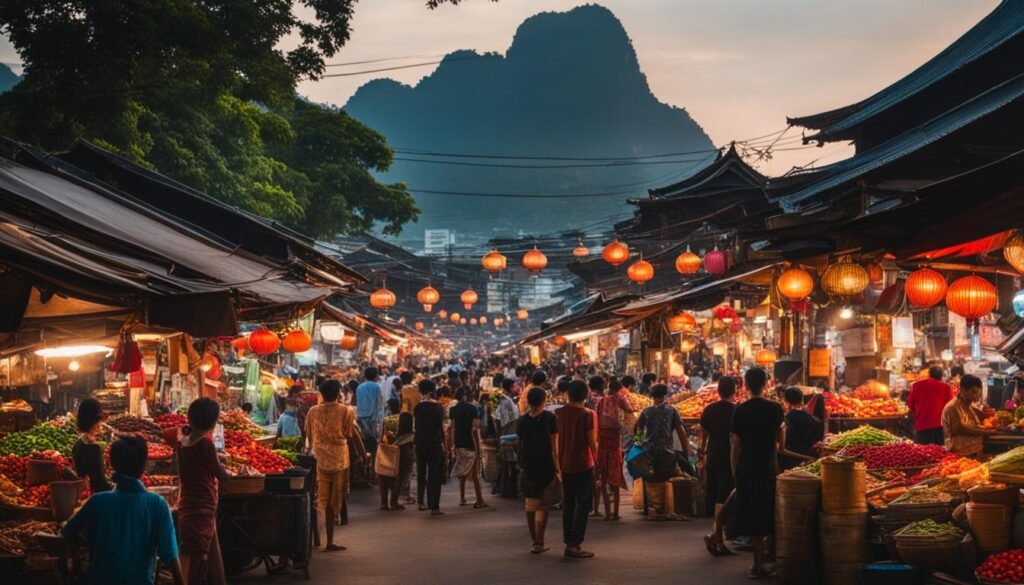Step into the enchanting realm of ancient temples in Southeast Asia and embark on an unforgettable journey through time. Marvel at the architectural masterpieces that have stood the test of time and bore witness to the rise and fall of powerful civilizations. As you venture through these awe-inspiring ancient religious structures in Southeast Asia, you will not only gain a deeper understanding of the region’s rich cultural heritage but also experience firsthand the spirit of unity and devotion that ancient societies held dear.
From the sprawling complex of Angkor Wat to the intricate stone carvings of Borobudur, Southeast Asia is home to an astounding array of cultural heritage sites. Whether you are a history enthusiast or simply captivated by the artistry and craftsmanship of bygone eras, temple exploration in this region offers something for everyone. So, let us guide you on a fascinating expedition, uncovering the secrets behind these extraordinary structures that have withstood the test of time and continue to inspire generations of visitors from around the globe.
Key Takeaways
- Explore the architectural marvels of ancient temples throughout Southeast Asia.
- Uncover the rich history and significance of these awe-inspiring cultural heritage sites.
- Learn about the unique construction techniques and materials that have allowed these temples to endure for centuries.
- Discover both world-renowned and hidden gems among the many temple sites in the region.
- Gain a deeper appreciation for the skill, craftsmanship, and cultural influences that shaped these masterpieces of ancient architecture.
The Enigma of Ancient Temple Architecture in Southeast Asia
Discover how Southeast Asia’s temple architecture is a physical manifestation of the region’s deep spiritual roots and aesthetic values. This segment will explore how ancient societies blended their religious beliefs with architectural ingenuity to create structures that are as much a feast for the eyes as they are a sanctuary for the soul.

The Intersection of Aesthetics and Spirituality
The timeless beauty and grandeur of ancient southeast asian temples not only served as centers of worship but also communicated the cultural values of their communities. By examining the religious history of southeast asia, one can gain a deeper understanding of how art and spirituality were intertwined.
“Art is a language and the purpose of all language is to express the beauty of the spirit.”
— Ananda Coomaraswamy, philosopher, art historian, and scholar on Indian and Southeast Asian Art
Historical temples in southeast asia showcase a fascinating fusion of local and outside influences, often blending Indian, Chinese, and indigenous architectural styles. This convergence is apparent in the stone carvings, intricate designs, and ornate decorations that adorn these ancient monuments.
Techniques and Materials: Building for Eternity
Ancient temple construction techniques and materials employed by southeast asian civilizations demonstrated remarkable ingenuity, allowing these structures to withstand the test of time. From structural planning to highly skilled craftsmanship, every aspect of temple building reflected the devotion and ambition of those who designed and erected these awe-inspiring religious monuments.
- Edifice Engineering: The use of advanced engineering techniques, such as corbel arches and post-and-lintel structures, ensured stability and longevity.
- Stone Carving: Artisans painstakingly carved intricate designs and narratives onto stone facades, leaving behind a visual record of their beliefs and history.
- Materials Mastery: Use of locally available materials, such as sandstone, laterite, and volcanic rock, enabled temple builders to harmonize with their natural environment.
An in-depth exploration of southeast asian archaeological sites provides insights into the legacies of these master architects and builders. The impressive scale and complexity of their creations continue to captivate modern observers, making ancient temple architecture an enduring testament to human ingenuity and perseverance.
| Temple | Location | Architectural Style | Materials |
|---|---|---|---|
| Angkor Wat | Cambodia | Khmer Architecture | Sandstone |
| Borobudur | Indonesia | Indo-Javanese | Volcanic rock |
| Bagan Temples | Myanmar | Burmese Style | Brick and Stucco |
| Wat Phra That Doi Suthep | Thailand | Lanna Architecture | Laterite and Bronze |
Unraveling the Historical Significance of Southeast Asia’s Sacred Sites
Embarking upon a historical odyssey to comprehend the full significance of the sacred temples of Southeast Asia is essential for any traveler or history enthusiast. These ancienthistorical siteshave played a pivotal role throughout Southeast Asia’s turbulent history, acting as centers of learning, bastions of power, and symbols of resistance. As a result, their importance transcends the spiritual realm, providing invaluable insight into the region’s rich cultural heritage.

Throughout the centuries, these sacred temples served diverse functions, reflecting the changing sociopolitical landscape and the region’s evolving religious beliefs. Let’s delve into some significant historical roles of these sacred temples:
- Centers of Learning: They were not only places of worship but also nurtured knowledge and learning, creating hubs for scholars, monks, and students to engage in intellectual discourse and preserve ancient wisdom.
- Political Powerhouses: Ancient rulers often built vast temple complexes to reinforce their prestige, showcase their vast wealth, and legitimize their rule. Temples often symbolized grand statements of the ruling power and facilitated the identification of the respective dynasties.
- Strongholds of Resistance: During turbulent times, temples served as strategic strongholds for military and political resistance. Their fortified walls and structures allowed them to withstand attacks and incursions, playing a critical role in historical conflicts of the region.
Today, these temples serve as fascinating reminders of Southeast Asia’s glorious past, revealing the spiritual, social, and political dynamics of the region’s long-lost civilizations. Guided by these insights, the importance of southeast asia temple restoration projects in preserving these extraordinary heritage sites becomes even more apparent.
My temple is the temple of learning, and not a single corner of it can be disregarded. As a spiritual being, one must tread the spiritual path all the time. – Swami Vivekananda
Restoration projects play a crucial role in securing the physical integrity of these temples, ensuring their stories continue to captivate and inspire future generations. Addressing threats such as theft, vandalism, and natural disasters, these initiatives enable us to delve deeper into Southeast Asia’s rich historical tapestry and appreciate the marvels of these architectural masterpieces.
In summary, the sacred temples of Southeast Asia embody historical complexity, intertwining spirituality with social, cultural, and political narratives. Unraveling their significance allows us to appreciate their intricate roles and the importance of preservation initiatives. As you continue your exploration of these enchantinghistorical sites, let their stories be your guide, illuminating the past and fostering a profound connection to the region’s vibrant heritage.
Embark on a Pilgrimage to UNESCO Heritage Southeast Asian Temples
Discover the splendor of Southeast Asia’s UNESCO World Heritage sites as you embark on a virtual pilgrimage to some of the region’s most significant temples. Experience the awe-inspiring beauty of Angkor Wat and other historical landmarks that illuminate the shared cultural, spiritual, and artistic heritage of Southeast Asia.

Famous Setpieces: Angkor Wat and Beyond
At the top of the list of southeast asian pilgrimage sites is Angkor Wat, an architectural masterpiece built in the 12th century. This monumental temple complex in Cambodia spans over 400 square kilometers and encompasses a vast array of temples, hydraulic structures, and communication routes. As you explore these cultural heritage landmarks, take a moment to appreciate the intricate carvings and reliefs depicting scenes from Hindu mythology that adorn these magnificent monuments.
Other noteworthy historic temples and ruins in southeast asia that carry the UNESCO World Heritage designation include:
- Borobudur Temple Compounds in Indonesia
- Temple of Preah Vihear in Cambodia
- My Son Sanctuary in Vietnam
- Prambanan Temple Compounds in Indonesia
Conservation and Restoration: Preserving History
As these precious historical monuments endure the ravages of time, southeast asia temple restoration projects play a vital role in their survival. UNESCO has allocated substantial resources towards the preservation and conservation of these sites, enlisting the help of international teams of archaeologists, conservators, and local communities. This coordinated effort aims to maintain the structural integrity and authenticity of these ancient landmarks while minimizing damage from modern-day threats such as pollution, encroaching urbanization, and natural disasters.
Here are a few examples of successful southeast asia temple restoration projects that have revitalized once-neglected heritage sites:
The restoration and stabilization of Angkor Wat’s Baphuon Temple, which involved dismantling the entire temple and reconstructing its 300,000 sandstone blocks
Conservation work on Indonesia’s Borobudur Temple, including the cleaning and chemical treatment of the temple’s stonework to counteract damage caused by air pollution
The development of a comprehensive management plan for Vietnam’s My Son Sanctuary, with the aim of safeguarding the site from the impact of increasing visitor numbers and climate change
As we stand in awe of these extraordinary landmarks, let us not forget the importance of conservation and restoration efforts that enable us to appreciate our shared cultural heritage for generations to come.
Discover Popular Tourist Attractions Among Southeast Asia’s Temples
With breathtaking architecture, rich history, and enduring religious significance, Southeast Asia’s temples have become popular tourist attractions among local and international visitors alike. To help you plan your spiritual adventure, we’ve compiled some must-visit temple sites that you should definitely include in your Southeast Asian temple tour itinerary.
Borobudur, Indonesia: This ancient Buddhist temple complex is one of the most famous landmarks in Indonesia. A UNESCO World Heritage Site, Borobudur’s intricately carved stone reliefs narrate the life of the Buddha and the principles of Buddhist cosmology. The temple offers stunning sunrise views, making it one of the most memorable experiences any visitor can have.
Angkor Wat, Cambodia: As the largest religious monument in the world, the ancient temple complex of Angkor Wat is a must-visit destination. The temple was originally built as a Hindu temple but was later converted into a Buddhist site. The magnificent architecture, intricate carvings, and surrounding moat form a dreamlike landscape that attracts millions of visitors each year.
Bagan, Myanmar: Over thousands of temples, pagodas, and monasteries adorn the ancient city of Bagan. Sunrise and sunset views across the temple-dotted plains are an unforgettable experience, and hot air balloon rides provide a unique perspective of the landscape.

Ayutthaya, Thailand: Once the capital of the ancient kingdom of Siam, Ayutthaya is dotted with the remnants of grand temples and palaces. Highlights include the Wat Mahathat with its iconic Buddha head overgrown with tree roots, and the red-brick Wat Chaiwatthanaram, which offers an atmospheric sunset experience.
Visiting Southeast Asia’s popular temples will immerse you in the beauty of ancient Southeast Asian civilization sites. To make the most of your journey, it’s important to know the best times to visit, how to respect local customs, and which sites to prioritize in your limited time:
- Best travel times: The dry season, from November to April, is generally the best time to visit Southeast Asian temples. Keep in mind that this is also high tourist season, so be prepared for crowds at popular tourist attractions.
- Respecting local customs: Dress modestly, covering shoulders and knees when visiting religious sites. It’s also essential to remove your shoes before entering any temple.
- Prioritize sites: While it’s impossible to visit every temple in these ancient Southeast Asian civilization sites, focusing on the most iconic and well-preserved sites will still give you a profound understanding of Southeast Asian history and culture.
In conclusion, embarking on a Southeast Asian temple tour is a unique and unforgettable adventure that takes you through the heart of ancient cultures, revealing the splendor, artistry, and devotion that still resonates today. Don’t miss the opportunity to experience the most popular tourist attractions, and let the ancient sites inspire you and fill your heart with wonder.
A Guide to the Hidden Gems Among Ancient Ruins
With countless temples scattered across Southeast Asia, there is no shortage of breathtaking ancient ruins waiting to be discovered. Venturing off the beaten path allows you to uncover the lesser-known hidden gems, offering a more intimate and serene journey into history. This guide will lead you to some of the region’s
lesser-known temples
Off the Beaten Path: Lesser-Known Temples
While the most famous temples may dominate travel brochures, Southeast Asia is also home to many secluded, ancient temples that deserve recognition. Here are a few:
- Preah Vihear Temple – A stunning 11th-century temple located atop a cliff on the Thai-Cambodian border. Dedicated to the Hindu god Shiva, it is prized for its intricate carvings and stunning views of the surrounding plains.
- Bantey Srei Temple – Also known as the “Citadel of Women,” this 10th-century Cambodian temple is renowned for its intricate, red sandstone carvings and is dedicated to the Hindu god Shiva.
- Mrauk U Temples – This collection of ancient temples is nestled in the lush hills of Myanmar’s Rakhine State and showcase the region’s rich cultural history.
- Gunung Kawi Temple – A sacred 11th-century temple complex in Bali, Indonesia, known for its ten impressive rock-cut shrines carved into a cliffside.
While the most famous temples may dominate travel brochures, Southeast Asia is also home to many secluded, ancient temples that deserve recognition.
To help you plan your exploration even better, we have compiled a table of these off the beaten path temples and their key features:
| Temple Name | Location | Notable Features |
|---|---|---|
| Preah Vihear Temple | Thai-Cambodian border | Intricate carvings, stunning views |
| Bantey Srei Temple | Cambodia | Red sandstone carvings |
| Mrauk U Temples | Rakhine State, Myanmar | Lush hills, rich cultural history |
| Gunung Kawi Temple | Bali, Indonesia | Rock-cut shrines |
When embarking on your journey, remember to respect local customs and the environment. Venturing off the beaten path often means exploring unspoiled and fragile areas, so take care to preserve these sites for future generations. As you journey through these
hidden gems
, savor the serene atmosphere and allow your imagination to wander through the ancient past.
Southeast Asian Cultural Heritage Sites Through The Ages
The temples of Southeast Asia have witnessed numerous cultural and historical transformations over the centuries. From ancient religious structures to unique historical temples, these architectural marvels are a testament to the region’s rich and diverse heritage. This section will trace the development of these magnificent sites and reveal how they have both shaped and been influenced by the changing cultural landscape of successive epochs.

Recognizing the significance of these temples, many of them have been designated as Southeast Asian cultural heritage sites , both at national and international levels. The evolution of these heritage sites reflects the bold experimentation, the artistic sensibilities, and the progressive blending of local and outside influences.
” Temples are the spiritual and cultural heart of the community, where the people not only come to worship but also to learn, to interact, and to sustain their cultural memory. ”
Below is a brief overview of the different historical temples and the eras they represent in Southeast Asia:
| Era | Temples | Cultural Significance |
|---|---|---|
| Pre-Angkor (before 9th century) | Sambor Prei Kuk, Cambodia | Earliest examples of temple architecture in Southeast Asia, showcasing the foundations of a unique architectural style. |
| Angkor Era (9th-15th century) | Angkor Wat, Bayon, Ta Prohm, Cambodia | The zenith of ancient Khmer architecture, incorporating Hindu and Buddhist elements, emblematic of the region’s rich religious and cultural history. |
| Post-Angkor Era (15th-17th century) | Sukhothai Historical Park, Thailand | Characterized by the proliferation of Theravada Buddhism and the integration of the local and Sri Lankan artistic styles. |
| Colonial Period (16th-19th century) | Wat Phra That Lampang Luang, Thailand | Exemplifies the preservation of traditional architectural styles, despite the influence of colonial powers in the region. |
| Post-Colonial Period (20th century-present) | Shwedagon Pagoda, Myanmar | Represents the revival of ancient religious traditions, fusing modernity and history in a harmonious architectural expression. |
As you explore the astonishing array of historical temples in Southeast Asia , take time to appreciate not only their architectural beauty but also the stories they harbor within their walls. Guided by the understanding of their cultural significance, one can forge a deeper connection with these wondrous sites, embodying the soul of a region that is proud of its past and looks confidently toward the future.
Religious Monuments of Southeast Asia: A Window into Ancient Civilizations
Southeast Asia is home to a treasure trove of ancient religious monuments that offer windows into the past, telling stories of civilizations long gone. These temples and sacred sites have played a crucial role in shaping societies, leaving a lasting impression on the history, culture, and architecture of the region.
One way to better understand the cultural fiber of ancient Southeast Asian civilizations is by examining the societal influence of temples in everyday life. By looking at the temples’ diverse roles, ranging from communal gatherings to being the nexus of education, economy, and governance, it becomes clear that these religious monuments have shaped ancient societies in more ways than one.
Societal Influence: The Temple’s Role in Ancient Communities
Temples in Southeast Asia were not only places for worship but also served as robust pillars of community life. The following outline explores the multifaceted roles of these religious monuments in ancient civilizations.
- Communal Gatherings: Temples played a central role in fostering community bonds, hosting regular religious ceremonies, festivals, and other events that brought people together.
- Education: Temples often functioned as centers of learning, nurturing an environment where religious teachings, philosophy, and ancient texts were taught and discussed. Monks and priests provided education to the people and propagated religious enlightenment.
- Economy: Through the collection of tithes and donations, temples served as economic powerhouses that fed the community, supported the needy, and financed various projects, including temple construction and expansion.
- Political Power: Temples were often brick and mortar embodiments of political authority, closely linked to the ruling elite or royalty. Sovereignty sometimes derived legitimacy from religious sanction, manifesting in the construction of grand temples to flaunt their divine right to rule.
- Governance: Temples acted as hubs for the administration of laws, mediation of disputes, and decision-making processes, strengthening social order and harmony.

Temples played an indispensable role in the fabric of ancient Southeast Asian societies, shaping the region’s landscape, culture, and mindsets. The grandeur of these religious monuments was a testament to the richness of these civilizations, encapsulating the dreams, beliefs, and ambitions of their people.
“The past influences the present, and the religious monuments of Southeast Asia hold the key to understanding the societal structure and spirituality of ancient civilizations.”
It is through this exploration of Southeast Asia’s religious monuments and their societal influence that we gain a deeper appreciation for the region’s rich history and cultural heritage. By studying these magnificent temples, we unlock the secrets of the past and grasp a better understanding of the civilizations that once thrived in Southeast Asia.
Temple Architecture in Southeast Asia: A Study of Style and Symbolism
The temple architecture in Southeast Asia reflects the rich cultural heritage and spiritual beliefs of the ancient civilizations. This section delves into the intricate details and symbolism of these magnificent structures, revealing the deep layers of meaning embedded in their design.

Ancient Southeast Asian temples are a testament to the architectural prowess and religious devotion of civilizations past, blending aesthetics and spirituality to create timeless masterpieces.
Styles of Temple Architecture in Southeast Asia
There are various architectural styles prevalent in ancient Southeast Asian temples. Some of the most prominent styles include:
- Khmer architecture – characterized by its massive stone structures, intricate carvings, and towering spires, best exemplified by Cambodia’s Angkor Wat.
- Javanese architecture – marked by its tiered, stepped pyramids adorned with bas-reliefs and statues, such as the ninth-century Buddhist temple of Borobudur in Indonesia.
- class=”Thai architecture – distinguishable by its steep, multi-tiered roofs, intricate gold decorations, and pointed roof finials, seen in the Grand Palace complex in Bangkok, Thailand.
Each architectural style has its distinctive features that lend to the overall visual impact of the temple complex.
Symbolism in Temple Architecture
The architecture of these ancient structures is replete with symbolism, the meaning of which often transcends aesthetic appeal to communicate deeply rooted religious and cultural beliefs. Some common elements of symbolic significance include:
- Stone carvings and bas-reliefs – depicting scenes from religious texts, history, and daily life, these carvings serve to immortalize the beliefs and stories that shaped the culture of the ancient civilization.
- Garuda statues – representing the mythical bird and mount of the Hindu god Vishnu, these statues symbolize protection and authority.
- Nāga balustrades – serpentine dragon-like creatures that guard the entrances to temples, embodying the protective power of the divine as well as the cosmic balance between good and evil.
Understanding these symbols deepens the appreciation for the intricate artistry and craftsmanship displayed within these temples, as well as the reverence for the divine that inspired their creation.
| Architectural Style | Notable Features | Examples |
|---|---|---|
| Khmer Architecture | Massive stone structures, intricate carvings, towering spires | Angkor Wat, Cambodia |
| Javanese Architecture | Tiered, stepped pyramids, bas-reliefs, statues | Borobudur, Indonesia |
| Thai Architecture | Steep, multi-tiered roofs, gold decorations, pointed roof finials | Grand Palace, Bangkok, Thailand |
As you explore the temple architecture in Southeast Asia, the rich tapestry of style and symbolism reveals an intricate, visually stunning language that continues to communicate the grandeur and reverence of ancient Southeast Asian civilizations to this day.
In Summary: Southeast Asia’s Ancient Temples — A Journey Through Time
Our exploration of ancient temples in Southeast Asia sheds light on the region’s rich religious history which has captivated the world for centuries. These awe-inspiring structures provide valuable insights into bygone civilizations, their spiritual beliefs, and architectural prowess. From the UNESCO World Heritage Sites, like the iconic Angkor Wat, to lesser-known treasures hidden off the beaten path, each temple carries with it a unique story that continues to resonate with visitors today.
These historic landmarks have found a renewed sense of purpose through ongoing restoration projects, playing an essential role in preserving Southeast Asia’s cultural heritage. Conservationists work tirelessly to ensure that these temples, representing innumerable years of history, remain intact for future generations to appreciate and explore. Their efforts not only safeguard these stunning sites but also contribute to the wider understanding of ancient religious structures and their lasting impact on Southeast Asian societies.
As we reflect on our journey through the enchanting world of Southeast Asia’s ancient temples, it is evident that the magnificence and spiritual resonance they exude continues to leave a profound impression on visitors from around the globe. Whether you’re a history enthusiast, an art lover, a spiritual seeker, or a casual tourist, these extraordinary landmarks beckon you to witness their timeless wonder firsthand and discover the enduring legacy they hold within their majestic walls.
FAQ
What are some well-known ancient temples in Southeast Asia?
Popular ancient temples include Angkor Wat in Cambodia, Borobudur in Indonesia, and Bagan in Myanmar. Other notable sites are Ayutthaya in Thailand, My Son in Vietnam, and Prambanan in Indonesia.
Why is ancient temple architecture in Southeast Asia significant?
Ancient temple architecture in Southeast Asia reflects the region’s deep spiritual roots, aesthetic values, and the ingenuity of ancient civilizations. These structures are testaments to the builders’ ability to harmonize with their environment and create buildings that serve both spiritual and aesthetic purposes.
How are Southeast Asia’s sacred sites historically significant?
Sacred sites in Southeast Asia have played various roles throughout history, such as centers of learning, bastions of power and resistance, and repositories of cultural heritage. They also serve as touchstones for the region’s spiritual and religious history, allowing us to understand how different civilizations interacted with one another.
What are some UNESCO World Heritage Sites in Southeast Asia?
UNESCO World Heritage Sites in Southeast Asia include the Temple Zone of Angkor Wat, the Cultural Landscape of Bali Province, the Historic City of Ayutthaya, and the Complex of Hue Monuments. These sites embody the cultural, religious, and historical significance of the region and its ancient civilizations.
Which ancient temple sites are considered hidden gems in Southeast Asia?
Off the beaten path, you can find hidden gems like Preah Vihear in Cambodia, Mrauk U in Myanmar, the Plain of Jars in Laos, and Gunung Kawi in Indonesia. These sites often offer a more serene and intimate experience than their more famous counterparts.
What role did ancient temples play in the daily life of Southeast Asian societies?
Temples played a central role in ancient Southeast Asian societies, functioning as places for communal gatherings, education, economic activity, and governance. They greatly influenced the social landscape and served as epicenters of community life and cultural development.
How do style and symbolism factor into temple architecture in Southeast Asia?
Style and symbolism in Southeast Asian temple architecture offer insight into the religious beliefs, artistic expressions, and social values of their respective civilizations. Aesthetic choices and symbolic representations often convey stories regarding myths, legends, and divine powers, providing a visual language that encapsulates a society’s worldview.



